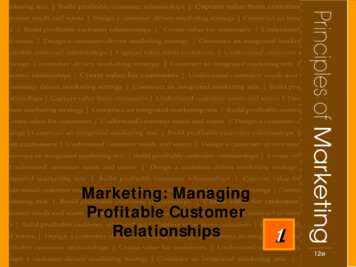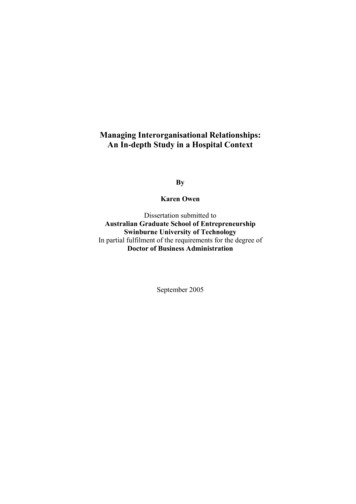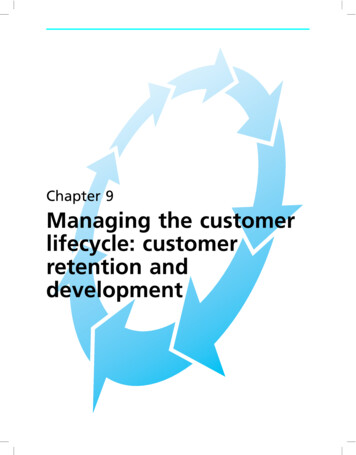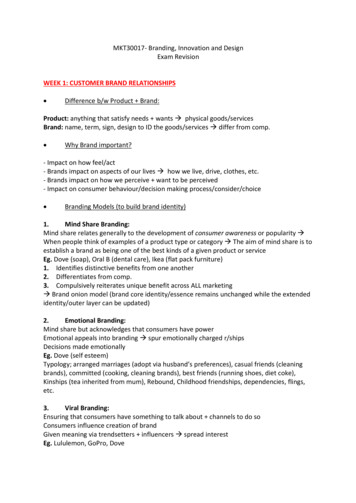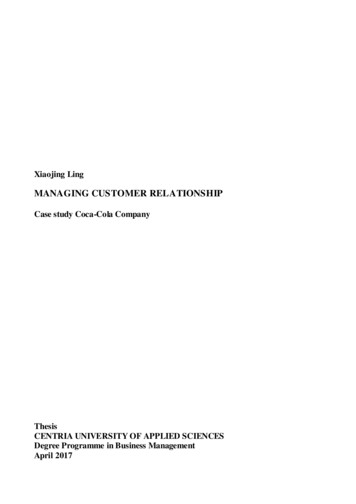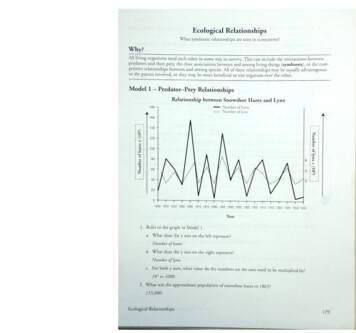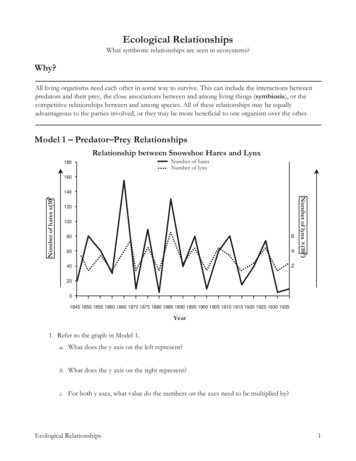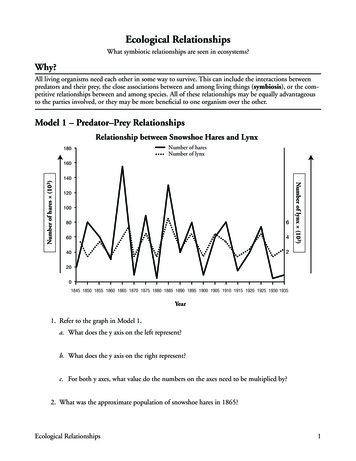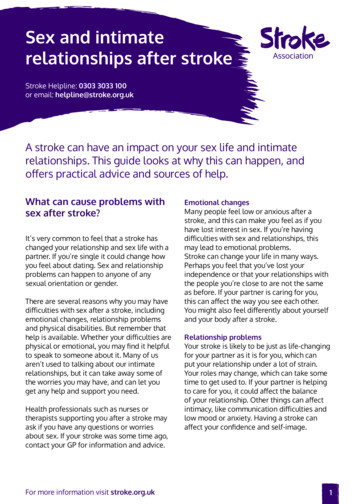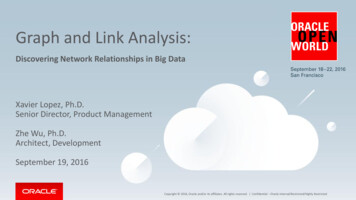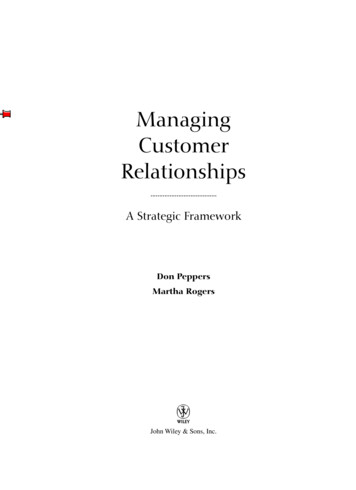
Transcription
ffirs.qxd 3/1/04 10:16 AM Page iManagingCustomerRelationships.A Strategic FrameworkDon PeppersMartha RogersJohn Wiley & Sons, Inc.
fpref.qxd 3/1/04 10:16 AM Page xii
ffirs.qxd 3/1/04 10:16 AM Page iManagingCustomerRelationships.A Strategic FrameworkDon PeppersMartha RogersJohn Wiley & Sons, Inc.
ffirs.qxd 3/1/04 10:16 AM Page iiThis book is printed on acid-free paper. 嘷 Copyright 2004 by Don Peppers and Martha Rogers. All rights reserved.Published by John Wiley & Sons, Inc., Hoboken, New JerseyPublished simultaneously in CanadaNo part of this publication may be reproduced, stored in a retrieval system, or transmitted in any formor by any means, electronic, mechanical, photocopying, recording, scanning, or otherwise, except aspermitted under Section 107 or 108 of the 1976 United States Copyright Act, without either the priorwritten permission of the Publisher, or authorization through payment of the appropriate per-copy feeto the Copyright Clearance Center, Inc., 222 Rosewood Drive, Danvers, MA 01923, 978-750-8400,fax 978-646-8600, or on the web at www.copyright.com. Requests to the Publisher for permissionshould be addressed to the Permissions Department, John Wiley & Sons, Inc., 111 River Street,Hoboken, NJ 07030, 201-748-6011, fax 201-748-6008.Limit of Liability/Disclaimer of Warranty: While the publisher and author have used their best effortsin preparing this book, they make no representations or warranties with respect to the accuracy orcompleteness of the contents of this book and specifically disclaim any implied warranties ofmerchantability or fitness for a particular purpose. No warranty may be created or extended by salesrepresentatives or written sales materials. The advice and strategies contained herein may not besuitable for your situation. You should consult with a professional where appropriate. Neither thepublisher nor author shall be liable for any loss of profit or any other commercial damages, includingbut not limited to special, incidental, consequential, or other damages.For general information on our other products and services, or technical support, please contact ourCustomer Care Department within the United States at 800-762-2974, outside the United States at317-572-3993 or fax 317-572-4002.Wiley also publishes its books in a variety of electronic formats. Some content that appears in print maynot be available in electronic books.For more information about Wiley products, visit our Web site at www.wiley.com.Library of Congress Cataloging-in-Publication Data:Peppers, Don.Managing customer relationships : a strategic framework / Don Peppers, Martha Rogers.p. cm.Includes index.ISBN 0-471-48590-X (cloth)1. Customer relations—Management. 2. Consumers’ preferences. 3. Relationship marketing.4. Marketing information systems. 5. Information storage and retrieval systems—Marketing.I. Rogers, Martha, Ph.D. II. Title.HF5415.5 .P458 2004658.8'12—dc222003020608Printed in the United States of America10987654321
ftoc.qxd 3/1/04 10:17 AM Page iiiContentsPrefaceviiPart OnePrinciples of Managing Customer Relationships1Chapter 1Evolution of Relationships with Customers3Roots of Customer Relationship ManagementThe View from Here511Philip KotlerGet, Keep, and Grow Customers in the Twenty-First Century17Roger SiboniWhat Is a Relationship?The Technology Revolution and the Customer RevolutionChapter 2The Thinking behind Customer RelationshipsWhat Characterizes a Relationship?Thinking about Relationship Theory1923353538Julie Edell BrittonJosh RoseCRM: The Customer’s View51James G. BarnesThe Nature of LoyaltyPart TwoChapter 356IDIC Implementation Process: A Model for ManagingCustomer Relationships63Customer Relationships: Basic Building Blocks of IDIC and Trust65Trust and Relationships Happen in TandemIDIC: Four Implementation Tasks for Creating and ManagingCustomer RelationshipsHow Does Trust Characterize a Learning Relationship?The Trust Equation: Generating Customer Trust66687172Charles H. GreenBecoming the Customer’s Trusted AgentRelationships Require Information, But Information Comes Onlywith Trust7881
ftoc.qxd 3/1/04 10:17 AM Page ivivChapter 4CONTENTSIdentifying CustomersIndividual Information Requires Customer RecognitionWhat Does “Identify” Mean?The Internet’s Role in Customer Identification: Betting on Amazon87889397Stewart AlsopCustomer Data RevolutionRole of Smart Markets in Managing Relationships with Customers98103Rashi GlazerChapter 5Differentiating Customers: Some Customers Are Worth More Than OthersCustomer Value Is a Future-Oriented VariableDifferent Customers Have Different ValuesConvergys: A Case Study in Using Proxy Variables to RankCustomers by Their Value113114120127Jill CollinsChapter 6Differentiating Customers by Their NeedsDefinitionsDifferentiating Customers by Need: An IllustrationUnderstanding NeedsUsing Needs Differentiation to Build Customer ValueDifferentiating Customers by Their Needs: A Practical Approach137138141145147148Jennifer B. MonahanNichole ClarkeLaura CococciaWilliam C. PinkValerie PopeckSophie VlessingChapter 7Interacting with Customers: Customer Collaboration StrategyDialogue RequirementsImplicit and Explicit BargainsSucceeding at Interaction Strategy Means Integrating across TouchpointsIntegrated Marketing Communications and CRM: Friends or Foes?161162164169172Don E. SchultzCustomer Interaction and Dialogue ManagementComplaining Customer as CollaboratorsChapter 8Using the Tools of Interactivity to Build Learning RelationshipsCustomer-Based Software SamplerUsing E-Mail to Interact with CustomersUsing E-Mail to Build Customer Value179185191192196196Derek ScruggsEvolution of the Customer Interaction Center in the Context of IDIC203Elizabeth RechWireless Rules: How New Mobile Technologies Will Transform CRMFred B. NewellKatherine N. Lemon, PhD208
ftoc.qxd 3/1/04 10:17 AM Page vvCONTENTSChapter 9Privacy and Customer FeedbackPermission Marketing213217Seth GodinPrivacy Issues for the Information Age223Josh W. StaileyStacey ScruggsIndividual Privacy and Data Protection228Larry A. Ponemon, PhDPrivacy in Europe Is a Different WorldPrivacy Pledges Build Enterprise TrustSubmitting Data OnlinePrivacy on the Net232235238241Esther DysonChapter 10Using Mass Customization to Build Learning RelationshipsHow Can Customization Be Profitable?You’re Only as Agile as Your Customers Think255256263B. Joseph Pine IITechnology Accelerates Mass CustomizationCustomization of Standardized Products and ServicesValue StreamsWho Will Write the New Business Rules for Personalization?277279282287Bruce KasanoffPart ThreeMeasuring and Managing to Build Customer Value297Chapter 11Measuring the Success of Customer-Based Initiatives299Brand Equity versus Customer EquityNature of Customer Loyalty: Attitude or Behavior?Economics of LoyaltyCustomer Profitability MetricsLongitudinal Metrics and Short-Term GainMeasuring Customer SatisfactionManaging Customer Relationships: Metrics Case Study300301302307309315321James GoodnightChapter 12Customer Analytics and the Customer-Strategy EnterpriseOptimizing Customer Relationships with Advanced Analytics341350Judy BayerRonald S. SwiftChapter 13Organizing and Managing the Profitable Customer-Strategy EnterpriseCapabilities for Forging Customer Relationships359363George S. DayRelationship GovernanceHow to Get There from Here: Transitions to Customer Management370375
ftoc.qxd 3/1/04 10:17 AM Page viviCONTENTSThe Manager of Portfolios of CustomersStages of Change to Become a Customer-Strategy Enterprise380381Miriam Washington KendallTransition across the EnterpriseManaging Employees in the Customer-Strategy EnterpriseOvercoming Employee Resistance386397397Marijo Puleo, PhDLoyalty-Based Management400Frederick F. ReichheldMomentum Building in the Customer-Based EnterpriseChapter 14Delivery Channel Issues of the Enterprise Focused on Building Customer ValueDealing with Channel PainDistribution System ManagementGeneral Motors’ Vauxhall Division: Managing the CustomerExperience across Channels and Touchpoints407411412417420Patricia B. SeyboldDemand Chain and DistributionSupply Chain Management and Managing Customer Relationships428430Roger BlackwellKristina StephanChapter 15Store of the Future and the Evolution of RetailingConsumer Direct ChannelUsing Operational Excellence as a Competitive Advantage: Tesco451454464Patricia B. SeyboldRonni T. MarshakThe Online Store and the Role of the Brand in Online Shopping472Ravi DharDick R. WittinkFinal Mile to ConsumersLogistics Business Models for SuccessAppendixWhere Do We Go From Here?Leadership Behavior of Customer Relationship ManagersManaging Customer Relationships: The Technology Adoption Life Cycle479483487488489Geoffrey A. MooreIndex498
fpref.qxd 3/1/04 10:16 AM Page viiPrefaceur goal with this book is to provide a methodical overview of the background,the methodology, and the particulars of managing customer relationshipsOfor competitive advantage. We begin with background and history, move throughan overview of relationship theory, outline the Identify-Differentiate-InteractCustomize (IDIC) framework, and then address metrics, data management, customer management and company organization, channel issues, and the store ofthe future. We end the book with an appendix called “Where Do We Go fromHere?,” which contains some very basic tools needed by individuals embarkingon a new career in managing customer relationships or—even more difficult—learning to help an existing company make the transition to using customer valueas the basis for executive decisions.Since January 1990, when we met and within five minutes had decided to writea book together, we began to question what would happen to marketing as a resultof the fractionalization of communication. It didn’t take us long to realize that thereal question that needed to be answered was bigger: What are the implications,for business, of information, interaction, and mass-customization technologies?The ongoing quest to answer that question, or at least to explore the nextlogical question, and the next, led us to write our first book, The One to OneFuture: Building Relationships One Customer at a Time (Currency/Doubleday,1993). In it, we hypothesized how technology might change the dimensions ofcompetitive strategy. We thought about the quest for share of customer ratherthan just market share, and the idea of managing customers, not just productsand brands. Before long, we had the opportunity to work with some bright pioneers in industry, who were wrestling through one-to-one and customer management. Based on four years of field experience, we wrote our second book,Enterprise One to One: Tools for Competing in the Interactive Age (Currency/Doubleday, 1997).Since then we have had the chance to speak at several colleges and universities, where more and more coursework and curricula are addressing electronicmedia, database marketing, and more importantly, customer relationship management, data analytics, and a host of related topics that serve to prepare business, management, marketing, information technology (IT), and statisticsstudents for careers in the growing field of competitive advantage throughunderstanding individual customers better, getting the most valuable ones foran enterprise, keeping them longer, and growing them bigger. We have alsotaught countless seminars and workshops and have worked in depth with consultants in the dozen worldwide offices of Peppers and Rogers Group, forclients who themselves have taught us a lot about what it takes to build customerequity. Our third book, The One to One Fieldbook: The Complete Toolkit for
fpref.qxd 3/1/04 10:16 AM Page viiiviiiPREFACEImplementing a One to One Marketing Program (Currency/Doubleday, 1999),coauthored with Bob Dorf, was a compendium of what we had learned abouthow to help people understand the basic principles. Our goal was to provide aframework for learning that was based on a methodology that we had tested andproven in a variety of client companies in a variety of industries around theworld. That was the beginning of the IDIC approach.Meanwhile, professors and classrooms across the United States and aroundthe world were beginning to teach one-to-one and customer relationship management (CRM). They sometimes used one of our early books as readings,along with other excellent work that was being published by a group of otherearly explorers on this and related topics. But the field was too new, and the academic market too small, to justify the work (yet) on an academic textbook ordesk reference per se.In 2000, NCR Teradata donated the funding for the Teradata CRM Center atFuqua School of Business at Duke University, where Martha is an adjunct professor and codirects the center. The center’s mission is threefold: to help supportrigorous academic research, to provide top-level teaching and curriculum materials, and to bring together academicians and practitioners for mutual learning.One of the first activities of the center was to support the background researchand project management of a textbook on managing customer relationships,which we agreed to write. (You can reach the Center, and take advantage of thehelp it offers professor and students for classroom learning as well as research,at www.teradataduke.org. You can reach us about this book at MCRtext@fuqua.duke.edu .)However, even though we welcomed the chance to codify and synthesize thelearning and thinking about managing customer relationships, we also thoughtthis book should not reflect just our views. Obviously, we know more about ourown work (some might say obsession) than about anyone else’s, and this bookpredictably draws heavily on our own experience from the past 10 years. Butwe had also been reading excellent work done by others, and so invited manyof them to share their views, to include their voices. Nearly everyone generouslyagreed, and we found that th
Chapter 13 Organizing and Managing the Profitable Customer-Strategy Enterprise 359. Capabilities for Forging Customer Relationships 363 . George S. Day. Relationship Governance 370 How to Get There from Here: Transitions to Customer Management 375. CONTENTS. v. ftoc.qxd 3/1/04 10:17AM Pagev. The Manager of Portfolios of Customers 380 Stages of Change to Become a Customer
